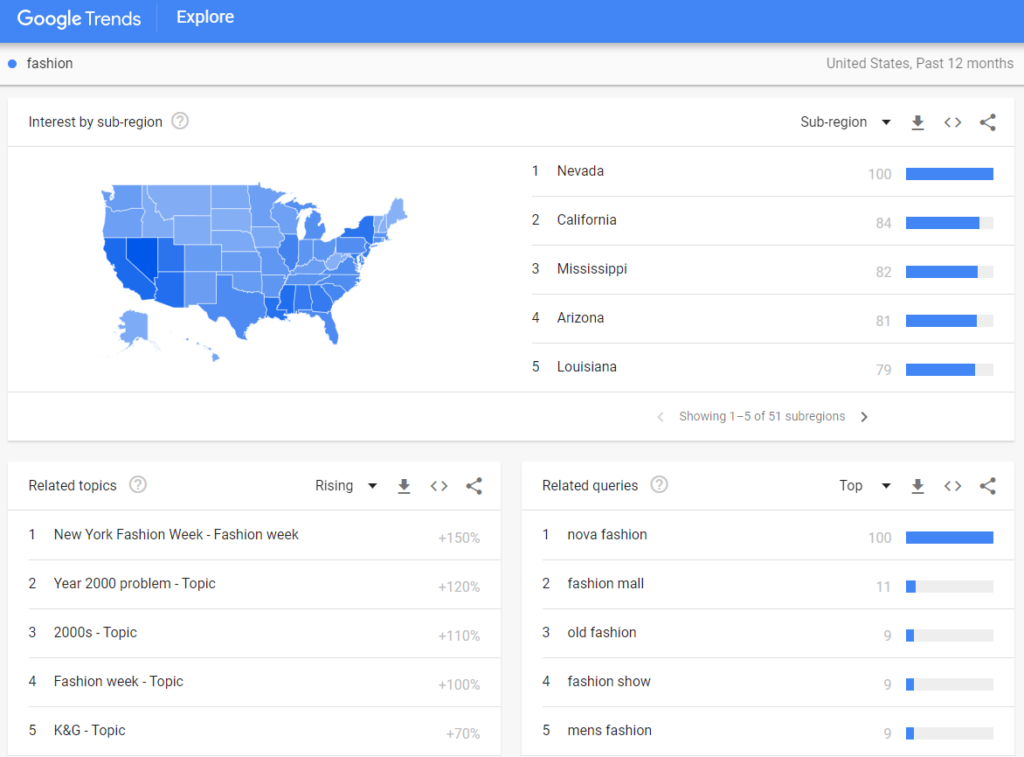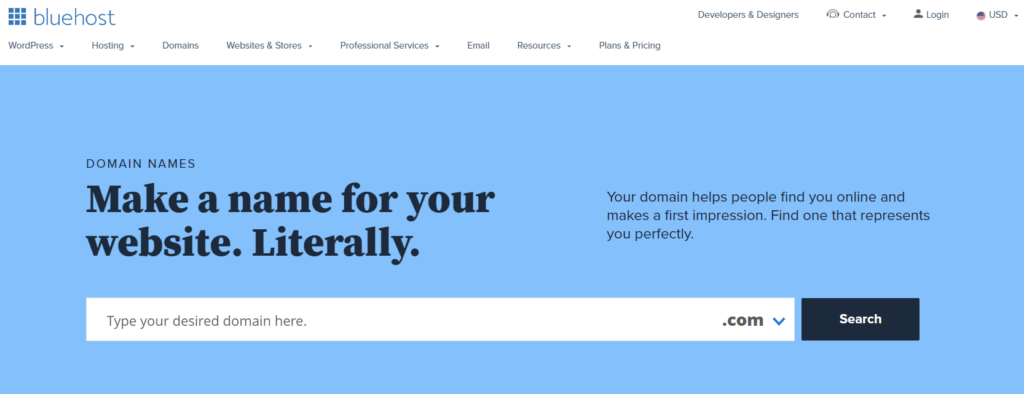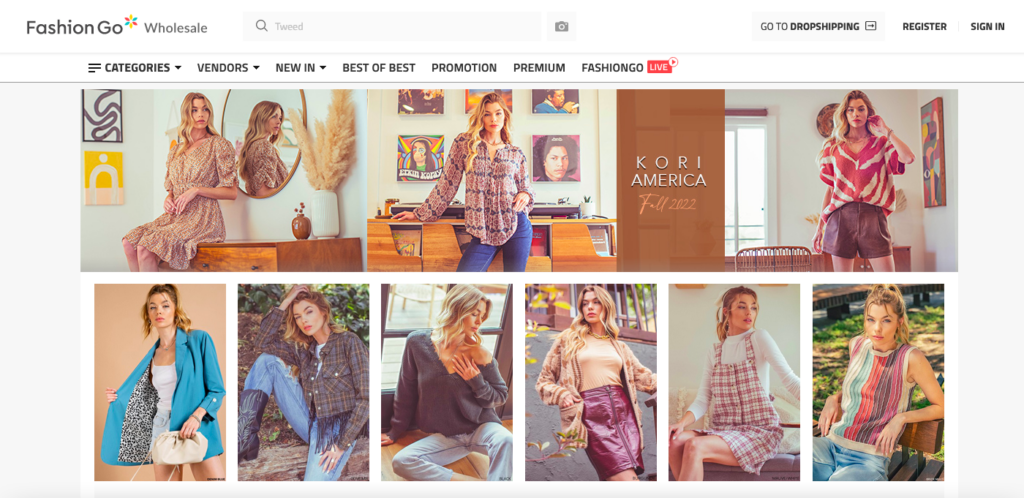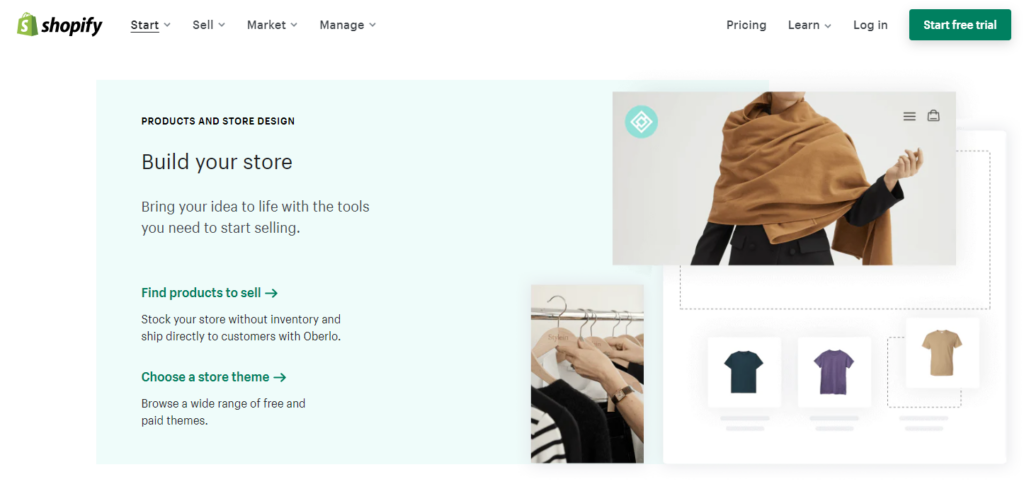If you’re dreaming about launching your own clothing business but affording the costs of a brick-and-mortar store seems impossible, starting an online clothing business can be a fun and highly lucrative alternative.
With so many people doing the majority of their shopping online, there’s never been a better time to start an online business.
eCommerce revenue worldwide is expected to hit a total of $4.15 trillion by the start of 2025, and online sales of clothing and apparel in the U.S. alone have already reached $180.5 billion. More eCommerce stats here.
So, why not get in on the action and start an apparel business online?
With careful consideration and planning, launching your clothing brand online can be a majorly rewarding experience.
Let’s take a look at how you can start selling clothes online in 2025.
How to Start an Online Clothing Boutique
Whether it’s your dream to design your own clothing line or to curate the perfect product collection.
This guide will get you started on your journey to creating your own online clothing store.
1. Find Your Niche and Your Target Audience

If you’ve been thinking about how to start an online clothing boutique, chances are you’ve already put a bit of thought into what your niche will be and who your potential customers are.
After all, different audiences will respond to different types of products and marketing strategies, so it’s worth sitting down and drawing up a description of your target audience, who they are, and how you can best connect with them.
If you’re not yet sure about your specific niche or target audience, try asking yourself a few questions:
- What are you passionate about?
- What kind of aesthetic appeals to you as a consumer?
- Where do you feel there are gaps or holes in the market that your store could fill?
As the famous fiction writer, Beverly Cleary advised her readers, “If you don’t see the book you want to read on the shelves, write it.”
The same advice goes for planning a business: if you don’t see the products you’re looking for on the market, why not design and/or sell them yourself?
You can also look at contemporary trends, examine what is gaining popularity, and try to get in while the market is hot.
Try to pay attention to the ads and trending looks that you see on social media, or check out popular fashion and trend-forecasting publications like Stylecaster.

For a more analytical approach, you can use Google Trends to analyze the direction that people’s aesthetic tastes (and thus the market) is heading in.
For example, streetwear, plus-size fashion, and organically sourced, sustainable clothing are all trends that have been accelerating in popularity for several years and show no sign of slowing down any time soon.
If you can find a way to put your own unique spin on these or another popular niche, your online fashion business will be off to a great start.
2. Choose a Name and Register Your Online Clothing Business
Your store’s name is the first thing your audience will know about it, so it’s important to choose carefully.
Try not to choose a name that’s catchy, easy to remember, and not too controversial (unless that’s what you’re going for).
When you think you’ve chosen a name, the most important thing to do is make sure that it’s available as a domain name and as a username on popular social media channels such as Instagram and Twitter.
To check if a domain name is available, you’ll need to use a domain registrar.

Popular domain registrars include GoDaddy and Namecheap, and pretty much every domain registrar will be able to tell you if your domain is already taken.
Note: it generally costs between $10-$20 a year to register a domain name, so you’ll want to factor that into your overall budget.
If your business’s name is already taken as a domain name or a social media username, it’s best to go in a different direction.
Once you have a name that works, it’s time to register your business.
It’s easy to get caught up in the excitement of envisioning your new business, but it’s important to remember the steps you have to take to start an online boutique legally.
There are a few different categories you can file your business under, with the two most common being LLCs (limited liability companies) and sole proprietorships.
If you intend to bring on employees or business partners at any point, then you should register your business as an LLC.
However, if your business is going to remain a one-person show, then you should file as a sole proprietorship.
If you live in the United States, you can do this either by filing the paperwork with your state’s Secretary of State office or by hiring a firm to handle the paperwork for you.
The exact steps to do this will vary depending on where you live, so you should look up the local procedures and requirements in your area.
3. Make a Business Plan
Although inspiration is important, having a good idea is only the first step toward creating a successful business.
Once you’ve identified your niche/your potential customer base and chosen a name, it’s time to draw up a business plan.
First, you’ll want to consider your business model. For example:
- Are you going to design and hand-create your own products yourself?
- Are you going to source them from independent designers, or from a larger wholesale supplier?
- Are you going to sell directly to individual customers, or sell your products wholesale to other stores?
- Are you going to have an inventory of products in stock at all times, or is dropshipping a better option for you?
All of these are viable business options with their own pros and cons, but they will definitely require very different business plans and marketing strategies to be successful.
Once you’ve figured out your basic business model, you need to draw up your budget. Running a company isn’t free, and the fashion industry isn’t cheap to break into.
Whether you’re designing and/or manufacturing your own products, selling wholesale, or dropshipping (more on that later), you should expect to spend at least a few thousand dollars to invest before you ever see a profit.
With different business models, there are different ways you can save money.
For example, if you’re designing and making your own products, you can wait to make a product until a customer places an order for it.
This way, you can save money on supplies and won’t have to store too much inventory.
However, even if you’re thrifty and plan your budget carefully, you should still be prepared to spend money on things such as materials and/or inventory suppliers, registering your business, and, of course, building and maintaining your website.
4. Start Designing Your Clothing and/or Sourcing Your Products

Once you’ve drawn up your business plan, it’s time to start sourcing your products.
If you’re designing the products you plan to sell, chances are you already have a lot of great ideas in mind.
If you’re planning to manufacture or hand-make them yourself, you’ll need the time and materials to turn your ideas into reality.
Alternatively, you could find a manufacturer to produce your designs for you.
If you see yourself as more of an aesthetic curator than a designer, you can search for wholesale retailers and buy only the products that you feel best reflect your store’s vision.
One popular online wholesaler is Fashiongo, but there are a ton of other options out there as well, and it’s worth doing the research to find the best fit for you.
Another option is dropshipping.
Dropshipping is a type of online retail in which you transfer orders that are placed on your eCommerce site directly to the manufacturer or wholesaler, who then sends the product directly to your customer.
With dropshipping, you still earn a profit, but you don’t have to worry about storing inventory or losing money if the products you’ve invested in don’t sell.
No matter how you choose to source your clothing store’s products, you’ll need to carefully calculate the price of each item based on how much you paid to source and/or manufacture it.
You certainly want to be earning a profit on each product you sell, but you also don’t want to price yourself out of the market.
Pro tip: make sure you’ve figured out the details of both your business plan and your inventory source before you start building your website.
While it’s tempting to jump right into creating the online fashion boutique of your dreams, it can often take several months to find and make a deal with a wholesaler or supplier.
Not to mention the time it takes if you’re hand-making your products, and there’s no reason to be paying for a website before you can actually accept orders.
5. Create Your Website

Now comes the fun part: how to start your own clothing website.
If you’re starting an online clothing business, it goes without saying that having a high-quality website is crucial to your business’s success.
Chances are you won’t have a physical, brick-and-mortar location (at least not yet), so your website will be one of the first and most important impressions that your customers get of your brand.
As such, designing and building a website that reflects the style and quality of your brand is critical. If it’s within your budget, you can hire a web developer to build a website for you.
However, this option is a bit too pricey for most businesses that are just starting out.
Fortunately, there are a ton of great eCommerce DIY website builders that you can use to build a beautiful, versatile website yourself (yes, even if you have no coding or web developing experience whatsoever).
Some of the most popular DIY eCommerce site builders are Shopify and Wix, which let you choose a template to customize with your own logo, color schemes, and products.
Some of these, such as Square Online and Ecwid, even offer free eCommerce site builder plans that allow you to build your online store without spending a dime.
If you’re comfortable using WordPress, you can opt for WooCommerce for even greater control over your site’s customization.
As I mentioned earlier, the cost of building your eCommerce website can vary a lot depending on how you build it and what kind of features you need.
As such, it’s important to calculate your budget carefully and be realistic about what kind of website you can afford.
It’s true that you have to spend money to make money, but you also have to avoid going broke before you’ve even had a chance to launch your business!
6. Build Your Brand and Marketing Strategy

You have your products, you have your shiny new website: now it’s time to let the world know about your business.
Marketing is a crucial part of any business endeavor, and with so many clothing brands competing for attention, it can seem almost impossible to stand out from the crowd.
But don’t worry: there are tons of ways to connect with customers, grow your audience, and make your online clothing business memorable.
To get you started, here are some valuable tips and tricks for marketing and increasing brand awareness:
- SEO is everything. SEO, or search engine optimization, is a marketing technique that helps determine how your site will be ranked on Google. It’s determined by a broad number of factors, including keywords, content relevance, and website loading speed. To improve your eCommerce site’s SEO performance, you can use one of the many popular keyword research tools. Many web hosting providers also offer SEO optimization tools (either for free or as paid add-ons) and these are definitely a worthwhile investment.
- Utilize social media. Google Ads, Instagram Ads, and Facebook Ads are all fantastic ways to connect with and grow your customer base, so make sure you factor in the cost of paid social media advertising into your business plan. You should also have your own social media pages across all popular platforms that you regularly update with fresh, topical content.
- Use an email marketing tool. These days, email marketing campaigns are a must for capturing your audience and ensuring that customers return. Brevo, GetResponse, MailerLite, and ActiveCampaign are four of the best email marketing tools on the market today, but you can check out my full list of email marketing tools for more options.
- Offer customer rewards. As part of your email marketing campaign, it’s a great idea to offer customer loyalty rewards, such as 20% off your second purchase or a buy one, get one 50% off deal.
- Collaborate with influencers. These days, many people buy products specifically because they’ve seen influencers using and recommending them, and a whopping 93% of professional marketers say they’ve worked with influencers as part of their marketing strategy. If you can find influencers in your niche to collaborate with, you have a major chance of boosting your sales.
- Give gift bags. Just because your clothing store is online doesn’t mean that the offline world is unimportant. Look for pop-ups, parties, and other public events that might appeal to your target audience and (if it’s within your budget) offer free gift bags with samples of your product. Everybody loves free stuff, and this is a great way to give your brand a more personalized face and make a memorable impression on customers.
Of course, this is not a full list of all the potential marketing strategies you can try. These days advertising is everywhere, so you’ll have to get creative to make your clothing store stand out from the rest.
Just remember that marketing is a marathon, not a sprint, so you don’t want to blow through your advertising budget too early.
7. Look for Partnerships and Investors (Optional)
The saying “no person is an island” could just as well apply to businesses.
In the tightly interconnected world of eCommerce, having strategic partnerships with other brands is a fantastic way to reach new audiences and grow your customer base.
You could reach out to other small businesses in your niche (or that appeal to your target audience) and propose collaborations that could be beneficial to both of you.
Alternatively, if you’re designing your own brand of clothing, you can reach out to already-established eCommerce stores and ask them to sell your brand on their site.
Before you do this, make sure you have a well-polished portfolio of your work and the ability to meet customer demand – after all, you don’t want to be making promises you can’t keep.
The same goes for looking for investors in your business.
Make sure you have a carefully crafted business proposal that includes realistic future profit projections to present to potential investors and give them a very clear breakdown of how their money will be spent if they invest in your endeavor.
Additionally, make sure that investing in your business looks like a deal too sweet to pass up.
Offer financial incentives such as partial ownership or an attractive percentage of the sales revenue once your business takes off.
8. Launch Your Clothing Business on the Internet
You’ve put in the hard work, and now you’re ready to release your eCommerce store into the world!
Make sure to launch your email and social media marketing campaigns at the same time as your website goes live, and have content prepared ahead of time to share on your own channels and accounts.
You should also make sure that you can keep up with customer demand, especially in the beginning: it definitely makes a bad impression if you have to tell first-time customers that they’ll have to wait weeks for their order to be fulfilled.
Be open to learning as you go along and to changing anything that seems like it’s not working.
How to Start a Small Online Clothing Business: Additional Advice
Here are a few more tips for how to start a successful online clothing store.
Set Realistic Goals
Let’s be real: you’re not going to launch your store and become Zara or Shein overnight.
Starting an online clothing business from home takes time, money, experience, and hard work, and you should be prepared (financially and psychologically) to operate at a loss for a while.
Setting realistic goals can help you not only deal with the ups and downs of starting a new business but also guide you to make smarter decisions.
For example, a realistic first-year goal for your eCommerce clothing store could be to increase profits by 20% every quarter.
This is a growth-oriented goal that will keep you striving, but also won’t set impossibly high expectations for profits that will very likely disappoint you when you fall short.
Consider Dropshipping
If you’re thinking about how to start a boutique business online and you’re not planning to design and/or manufacture your own clothing line, then dropshipping could be the perfect business plan for your eCommerce store.
Dropshipping is by far one of the easiest ways to start your own online boutique, as you don’t have to spend money (or storage space) on an inventory of products.
Instead, your store essentially functions as a middleman.
When orders come in, you pass them along to a wholesaler, who handles the fulfillment and delivery.
Dropshipping is rapidly growing in popularity and is arguably one of the best and most affordable ways to get into the eCommerce game since your startup costs will be pretty much limited to the costs of registering your business and building and maintaining your website.
The Bottom Line: How to Start up an Online Clothing Store
If starting a small online clothing business still seems overwhelming, don’t worry! Rome wasn’t built in a day, and your online clothing store won’t be either.
Start from your inspiration and build from there. Consider your niche, and your target audience, and then draw up a detailed business plan that includes a realistic budget.
From there, you can either start designing your own clothing or source it from a wholesaler or manufacturer.
Again, you want to make sure that you have enough inventory but also that you’re not stretching your budget too thin.
Alternatively, dropshipping is a way to sidestep the issue of inventory altogether and could be an attractive option if you’re not intent on designing your own line of products.
Once you know what you’re going to sell, it’s time to build your website and start creating a multi-faceted marketing campaign.
Although you can hire a web developer to build your website, the number of affordable, highly customizable DIY no-code eCommerce website builder tools on the market means that building your own website is probably your best bet.
At this stage, you can also start reaching out to potential investors and start thinking about partnerships with other brands or businesses.
Finally, it’s time to release your clothing business into the world! You’ve done the hardest part already, and now you’re finally ready to start reaping the rewards of your labor.
References
- https://www.bigcommerce.com/articles/ecommerce/how-to-start-an-online-clothing-store/
- https://www.goodreads.com/quotes/692214-if-you-don-t-see-the-book-you-want-on-the#:~:text=Learn%20more
- https://trends.google.com/trends/?geo=US
- https://stylecaster.com/fashion/
- https://influencermarketinghub.com/influencer-marketing-statistics/
